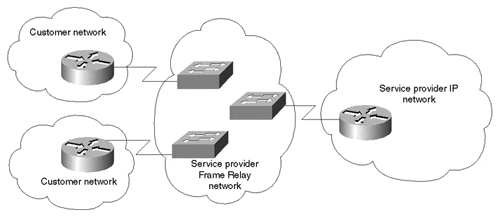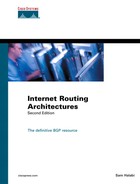ISP Services
Different ISPs offer different services, depending on how big they are and the infrastructure of their networks. Mainly, providers can be categorized by their method of physical Internet access, the applications they provide to customers, and the security services they provide.
The following sections cover the service models that are most common throughout the Internet service provider market today. As you'll see, these services range from providing dial-up access via a telephone line in your home to data center hosting facilities where you collocate your equipment and obtain connectivity locally.
Dedicated Internet Access
Dedicated Internet access is commonly provided at speeds of 56 kbps or 64 kbps up to T1/E1 lines (1.5 and 2 Mbps, respectively) on the lower end and T3/E3 (45 and 34 Mbps, respectively) and OC3 (155 Mbps) on the higher end. Dedicated Internet access providers are also beginning to provide OC12 (622 Mbps) and even OC48 (2.5 Gbps) high-speed access services. Dedicated access connections are used when bandwidth utilization is predictable and the frequency of network access is high enough to justify a line's being up 24 hours a day. Of course, the trade-off for dedicated access is cost, which is usually higher than for other access methods.
Dedicated Internet access usually involves termination of the physical circuit on the CPE (customer premises equipment) device, as well as direct circuit termination on an IP router on the service provider side. Link layer protocols such as PPP or Cisco HDLC (a derivative of PPP) are used for signaling and frame transfer across the connection. Figure 2-1 illustrates a typical dedicated Internet access configuration.
Figure 2-1. Dedicated Internet Access Configuration

Frame Relay and ATM Internet Access
Frame Relay and ATM (Asynchronous Transfer Mode) connections are among the most economical ways for corporations to connect to the Internet. Purchasing dedicated access connections with sufficient capacity can be prohibitively expensive for many companies, in which case they might consider connecting via existing Frame Relay or ATM services. With these alternative access methods, corporations can purchase enough bandwidth to meet their existing needs while providing a practical expansion path as bandwidth requirements increase.
Because service providers can statistically multiplex data from multiple subscribers over a single link and then backhaul the data to an IP network, prices associated with Frame Relay and ATM Internet access services are usually much lower than dedicated access. Figure 2-2 illustrates a typical Frame Relay Internet access model.
Figure 2-2. Frame Relay Internet Access

Frame Relay and ATM access services are particularly appealing to corporations that have existing Frame Relay and ATM networks. This is because service providers often provision access gateways from these networks to their IP networks, thereby requiring no additional infrastructure by the customer to accommodate the new connection.
Although Frame Relay, ATM, and dedicated Internet access all utilize the same underlying physical layer technologies, it's important to understand that ATM and Frame Relay services, in contrast to dedicated access, perform statistical multiplexing before providing access to the IP network. This statistical multiplexing is what allows service providers to perform an additional layer of service aggregation, thereby reducing the service's cost.
Understanding the amount of aggregation performed by the Frame Relay or ATM network, in addition to the Internet Gateway's capacity and resiliency design, is important. For example, an oversubscribed Internet Gateway could result in significant performance degradation on your Internet access circuit.
Dialup Services
Dialup services include traditional modem access, with speeds up to 56 kbps. They also include ISDN (Integrated Services Digital Network), BRI (Basic Rate Interface) of up to 128 kbps, and PRI (Primary Rate Interface) with speeds up to 1.5 Mbps. Dialup services range from servicing individual users to providing services to corporations that are subcontracting with providers to obtain all their remote login needs. ISDN, BRI, and PRI services have experienced tremendous growth over the past few years, primarily because of their on-demand (utilize only when needed) nature and their capability to carry digital signals used by multimedia applications such as video teleconferencing.
Digital Subscriber Line
Digital Subscriber Line (DSL) services provide high-speed, low-cost Internet access. They fit nicely between dialup and dedicated access services in terms of both price and speed. DSL service types vary based on which DSL technology is employed. The term xDSL is commonly used to refer to generic DSL services, where x can represent any of a number of different encoding techniques used across the physical line at Layer 1. Table 2-1 lists some of the more common types of DSL technologies and their characteristics.
| DSL Technology | Upstream Rates | Downstream Rates | Symmetric/Asymmetric | POTS Coexistence | Standardization |
|---|---|---|---|---|---|
| ADSL (Asymmetrical Digital Subscriber Line) | 16 kbps to 640 kbps | 1.5 to 8 Mbps | Asymmetric | Yes | Yes |
| HDSL (High-bit-rate Digital Subscriber Line) | Fixed 1544, 2048 kbps | Fixed 1544, 2048 kbps | Symmetric | No | Yes |
| SDSL (Symmetric Digital Subscriber Line) | 1.5 or 2.048 Mbps | 1.5 or 2.048 Mbps | Symmetric | Yes | No |
| VDSL (Very high-bit-rate Digital Subscriber Line) | 1.6 to 19.2 Mbps; distance-dependent | 12.96 Mbps at 4500 feet 55.2 Mbps at 1000 feet | Both | Yes | Under development |
A key benefit of DSL technology is that it can utilize existing twisted-pair copper loops in the Plain Old Telephone System (POTS) infrastructure, making it a popular residential and small-business access technology. Available DSL services usually vary significantly between providers and regions, with speeds ranging from 64 kbps up to 52 Mbps (VDSL). The quality of cable plants and the distance from the serving central office (CO) can have significant bearing on performance and throughput characteristics of a DSL connection. Over half a million DSL lines were deployed in the U.S. in 1999.
Cable Modems
Much like DSL, cable modems are a fast-growing access technology. Cable modems leverage the high-bandwidth potential of cable TV lines to provide data access services.
Because cable modem services were designed to utilize the existing fiber and coaxial cable TV infrastructure, which was optimized to carry one-way broadcasts, available bandwidth is usually very asymmetric in nature. For example, typical services provide capacity close to 2 Mbps downstream (to the subscriber's location) and 64 kbps upstream (to the service provider's network).
In addition, unlike DSL, which is a point-to-point technology, the downstream bandwidth is shared among multiple users of the service, thereby creating challenging security issues for manufacturers, service providers, and consumers.
Despite these challenges, cable modem services have been deployed for several years, and the number of subscribers and service availability is growing rapidly. There are nearly 2 million cable modem subscribers in the U.S. today, with projections as high as 16 million by the end of 2003.
Dedicated Hosting Services
Although hosting has been around almost as long as dedicated access services, it has become very popular over the past few years, with many service providers specializing in this market. Large providers that focus on dedicated hosting are commonly referred to as content providers. These providers usually develop highly fault-tolerant data center facilities that house cabinets or racks in which both enterprise and Web hosting customers can lease space and collocate servers and other computer equipment. Providers then sell Internet access to the collocating devices locally via technologies such as Fast Ethernet (100 Mbps) and Gigabit Ethernet (1 Gbps). Pricing models vary, and both usage-based and fixed-rate services are available.
Hosting providers often use high-end Ethernet switches to aggregate traffic from hundreds or thousands of collocated servers. Consumers should be concerned about upstream oversubscription ratios and fail-over mechanisms used by the provider. Also, because of security implications with large switched networks, consumers should be aware of if and how (usually with virtual LANs) the provider separates broadcast domains. In a shared switched network, common in the content-hosting model, understanding these issues is extremely important in order to prevent potential Denial of Service (DoS) attacks, unauthorized access to and visibility of data, and other security and management problems.
Hosting is definitely becoming very popular and is already a multibillion-dollar business by itself. It's also a market where consumers should be very cautious of what, where, and how their services are being provided. For more details about switches, VLANs, and broadcast domains, read Interconnections: Bridges, Routers, Switches, and Internetworking Protocols, Second Edition (Addison-Wesley, 1999) by Radia Perlman, or Cisco LAN Switching (Cisco Press, 1999) by Kennedy Clark and Kevin Hamilton.
Other ISP Services
Other higher-layer services include e-mail and news services, VPNs (Virtual Private Networks), and IP Multicast. As these and other new services continue to evolve, customers need to weigh their costs and benefits against proven available options. Be especially concerned with how the services are provisioned and managed, as well as the knowledge base of the associated support and engineering personnel.
Many ISPs also offer consulting and other value-added services, such as security. The simplest security services involve packet filters at the access device. Other evolving services include data encryption and virus scanning.
Prices can vary significantly based on a given provider's reliance on an access method (this is discussed further in the next section). Prices also vary significantly based on a given provider's investment in infrastructure and operations and engineering resources.
